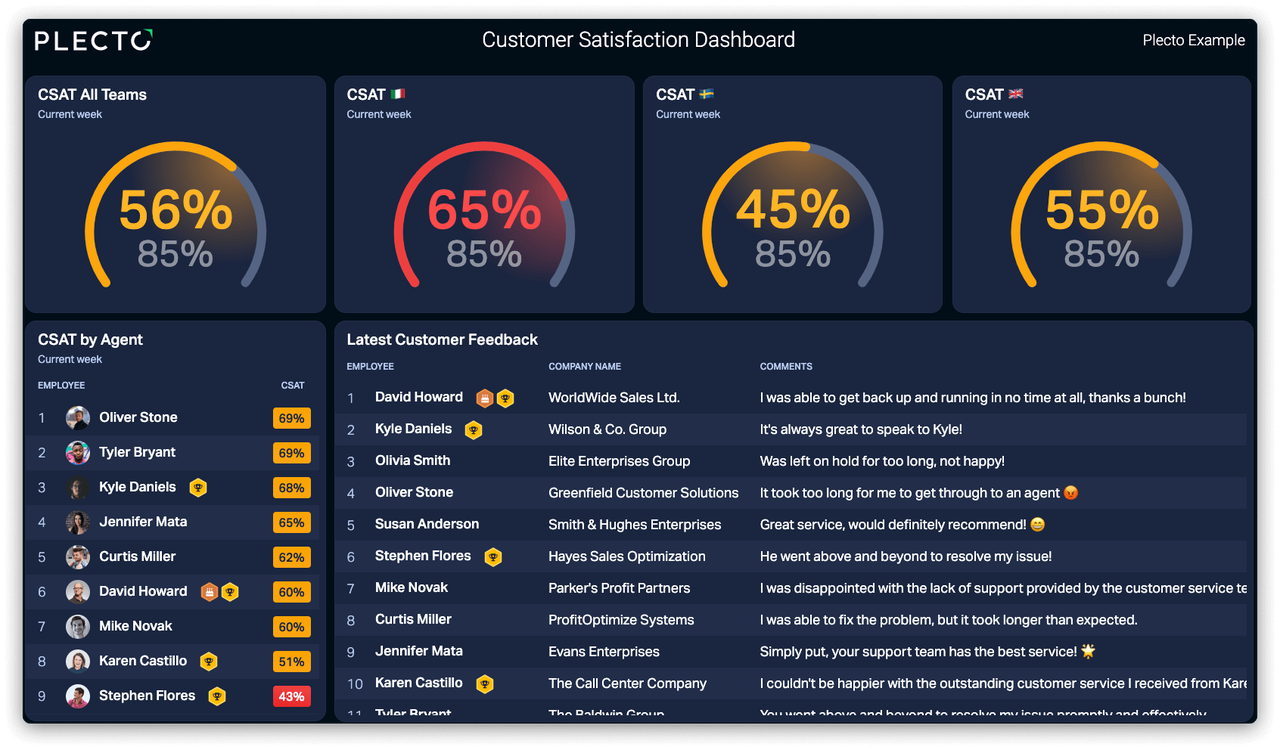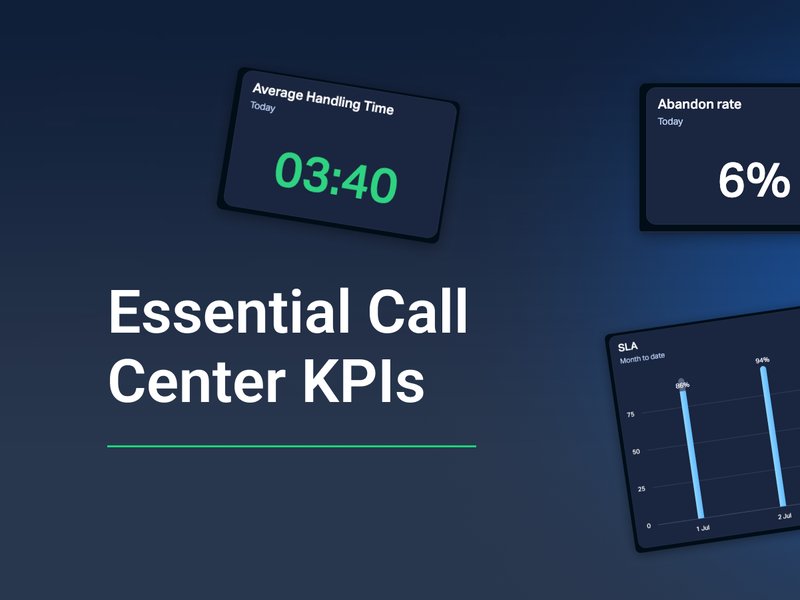Tracking the right help desk KPIs can help you measure your team’s ability to solve customers’ support inquiries to their satisfaction while ensuring optimal staffing levels and your team’s well-being. As competition increases in nearly every industry, service quality can become the crucial differentiator that secures long-term customer loyalty and those all-important word-of-mouth referrals!
Read on to discover the 12 help desk KPIs that are proven to uncover the insights you need in order to know whether your employees feel confident and fulfilled in their roles – and if they’re delivering the standard of support your customers expect.
12 Help Desk KPIs to Track in 2024
In addition to providing key insights you can use to improve your customer support, tracking the right help desk KPIs can boost your employees’ accountability and help keep everyone engaged in meeting or exceeding their goals. As omnichannel support becomes the gold standard and routine support requests are increasingly handled by self-service solutions like chatbots and knowledge bases, these KPIs can also provide insight into how well your company’s support options are meeting customers’ expectations.
1. Average Customer Satisfaction Score (CSAT)
This is a “big picture” KPI that provides a snapshot of whether customers are satisfied with your customer support. CSAT measures how well your help desk team met the customer’s expectations. It’s measured based on one question: On a scale of 1–5 how satisfied were you with the support you received today?
This is the formula to calculate CSAT:
CSAT = (Number of Positive Ratings (i.e., 4 or 5) / Total Number of Responses) x 100
Here are some current industry CSAT benchmarks for phone support:
- High: 95%
- Average: 87%
- Low: 76
2. Net Promoter Score (NPS)
NPS is a bit broader than CSAT. Instead of just measuring customer satisfaction, it measures loyalty based on the customer’s likelihood of recommending your company or product to others. Similar to CSAT, NPS is measured based on one question: On a scale of 1–10, how likely are you to recommend us to a friend?
Customers generally fall into three groups:
- Detractors: 0–6
- Passives: 7–8
- Promoters: 9–10
This is the formula to calculate NPS:NPS = Total Percentage of Promoters – Total Percentage of Detractors
Although NPS benchmarks vary by industry and location, these are some general guidelines from Bain & Company, who developed the NPS system:
- Above 0: Good
- Above 20: Favorable
- Above 50: Excellent
- Above 80: World-Class
3. Ticket Volume
Once you have a barometer of current customer satisfaction levels, you can take a more granular look into what’s driving them. Tracking ticket volume will reveal how many support tickets your help desk can handle within a specific timeframe – commonly per day, week, or month. This information can inform staffing decisions and help to ensure that you’re neither understaffed nor overstaffed. If you offer omnichannel support, consider tracking ticket volume by channel so that you train and staff the necessary competencies in proportion to forecasted demand. An agile team that can pivot between channels can help minimize staffing costs while still addressing support requests quickly and efficiently.
4. Ticket Status
This is a great metric for keeping tabs on your team’s pipeline. For a comprehensive overview of all support requests, track the number of open, solved, reopened, escalated, unassigned, and closed tickets. Over time, these stats should yield useful insights into areas where you could improve – for example, a high proportion of escalated or reopened tickets could be a clue that your first-line staff is undertrained or lacks the authority to make decisions.

5. Tickets by Type
Tracking tickets by type can help drive business decisions well beyond the help desk. For example, sharing frequent bug reports or feature-related requests with the product development team could help when prioritizing future product updates. If you’re getting a lot of setup requests, perhaps the onboarding process could use some work. Also look into common requests that could be addressed with self-service tools or better documentation. Customer retention takes a company-wide effort, and the help desk has a unique vantage point from which to identify customers’ needs and feed relevant information to those who can take action.
6. Average First Response Time
This help desk KPI tracks the average duration between a customer initiating a support request and their first communication with a member of the support team. This interval has been shown to directly impact customer satisfaction levels. Research reveals that 60% of customers feel that waiting for even one minute is too long. Fortunately, a quick acknowledgment of the service request is enough to quell any initial dissatisfaction and improve the chances of a satisfactory outcome. Providing a quick acknowledgement of incoming requests, even during peak times, is essential to maintaining a high CSAT.
7. Average Resolution Time
For many customers, contacting support is an unwelcome chore in an already packed schedule. Providing quick and easy solutions is a good strategy for securing long-term customer loyalty – while doing the opposite can lead to churn. Average resolution time measures how long it takes on average for customers to receive the support they need. This encompasses the total time it takes from when the ticket is opened until it’s closed. A low average resolution time indicates that the help desk team is adequately trained with the right competencies and has the authority to make decisions. However, it’s important to look at this in the context of adjacent metrics like reopened tickets.
Build your first dashboard.
Start your 14-day free trial today
8. First Contact Resolution (FCR)
A high FCR is a hallmark of accurate and efficient service. This KPI measures the percentage of requests the help desk is able to fully resolve the first time the customer contacts support. Quick and efficient support is an important customer satisfaction driver. It can also save the company money by reducing the number of inquiries needed to solve a single issue. Most experts recommend aiming for an FCR between 70 and 75 percent.
9. Agent Utilization
Achieving optimal staffing levels is one of the most challenging aspects of help desk management. If your agent utilization is too high, response times will be slow and customers are likely to be dissatisfied with the time it takes to handle their inquiries. Low utilization should enable swifter service but with a risk of employee downtime, which drives a higher cost per ticket. Tracking and optimizing your agent utilization should enable you to balance efficient support with reasonable costs. The magic utilization number is broadly agreed to be between 75 and 80 percent.
10. Employee Turnover Rate (ETR)
ETR tracks the percentage of employees who voluntarily resign within a given timeframe. Especially in companies supporting multiple or complex products, the cost of recruiting, training, and onboarding new help desk employees can be significant. In addition, high turnover can negatively affect CSAT because veteran support agents are spread thin while new hires need time to get up to speed. Keeping an eye on ETR as well as related metrics like agent utilization can help you identify negative trends and their source, empowering you to make the decisions that will retain more employees for longer.
Plecto can help you get the most out of these help desk KPIs!
Tracking these twelve help desk KPIs can provide a more data-informed overview of the quality and efficiency of your company’s help desk support.
Plecto offers integrations with many popular systems used by help desk teams, including Salesforce, HubSpot, Help Scout, and Intercom – making it easy for help desk teams to stay on top of their most important KPIs with real-time dashboards.
Sign up for a free 14-day trial and see how Plecto can help your team provide the correct and efficient support your customers expect!




